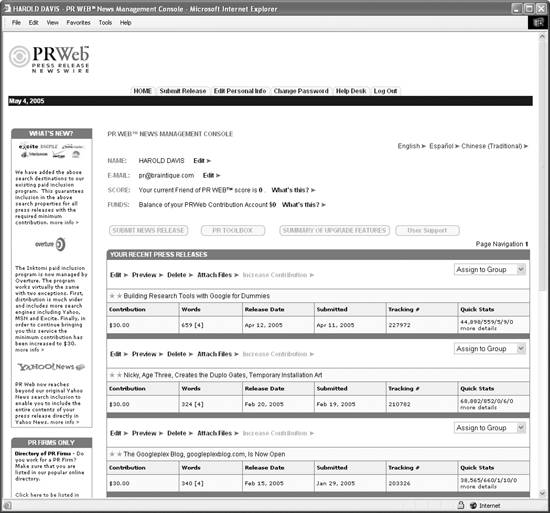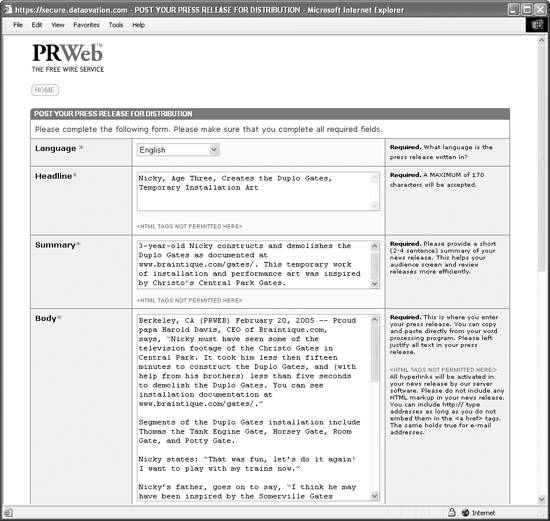Section 2.5. Publishing Press Releases
2.5. Publishing Press ReleasesIt used to be that putting out a press release was a big deal. It required special accreditation and membership in a wire service and could generally only be accomplished by large companies or by using an accredited public relations or ad agency. As with many other things, the Web has disintermediated and democratized the process of publishing a press releaseso much so that some large organizations don't even bother with them anymore, figuring that their releases will be lost in the flood of information unleashed on the world by the "little guys." These days, publishing a press release that will be picked up by wire services is technically free. In reality, to get the distribution you want for the release will cost you
about $30.00 per release. Although my general stance is not to pay for listings, this is usually well worth doing, provided you have the skills to write a good press release and have an interesting story to tellnot only will it produce inbound links but also some traditional media may pick up on your site and story. There are several online services that exist to distribute press releases, including 24-7PressRelease.com (http://www.24-7pressrelease.com), FreePressRelease.com (http://www.free-press-release.com/submit/), and PRWeb (http://www.prweb.com). These sites all work in essentially the same way: an online form is provided for your press release submission, and the service submits your release to wire services, web search engines, and anyone who subscribes to the service's feeds. Free submission is available from all of the press release services, but to get the distribution your press release deserves, you need to buy (in some cases, phrased as a "contribution" or a "donation") premium membership in the service (or upgrades for specific press releases). PRWeb is probably the best known of these services. To get started with PRWeb, you need to create a free account. Once you've established an account, you have access to a management console, shown in Figure 2-10, which lets you create, edit, and submit press releases and also check to see how many times each of your releases was viewed.
Figure 2-10. The PRWeb management console gives you access to press release creation, editing, and submission and allows you to monitor release statistics To create a new release for submission, click the Submit News Release button on the console. In the form that opens, shown in Figure 2-11, you can copy and paste the elements of your press release if you created it as a word-processing document (See "Preparing a Press Release," earlier in this chapter). You can edit the press release later, but you do need to supply the following elements initially:
When you've completed your press release and assigned a release date, click Save Press Release. You'll next be asked to pay for your submission (select a contribution level). Press releases are subject to a vetting process conducted both by software and human editors. Some kinds of content are forbidden. For example, you cannot submit a press release having to do with adult content and any related industries on PRWeb (see Chapter 6 for information about submitting adult-content press releases). You can find out more about PRWeb's review policies using the Knowledge Base on the PRWeb site. Generally, besides adult content, PRWeb will reject any outright Figure 2-11. If you've prepared a press release in your word processor, you can copy and paste into PRWeb's online form and apparent advertisements, so take care to word your press releases to avoid this stigmatization. If your press release is rejected, PRWeb will refund any contributions as a matter of course. Note that PRWeb does not vet spelling or grammar and does not check factsit's up to you to get these things right. Provided your press release has been accepted, you'll receive email confirmations and a link to your release online on the wire service site.
|
EAN: 2147483647
Pages: 145
